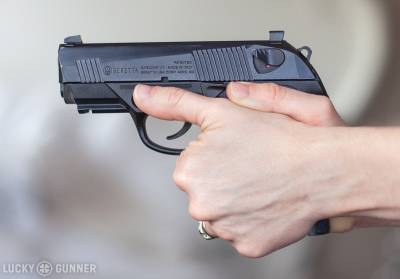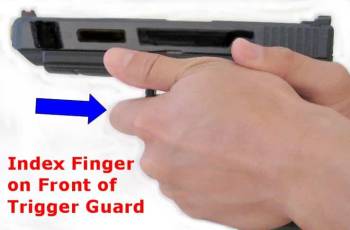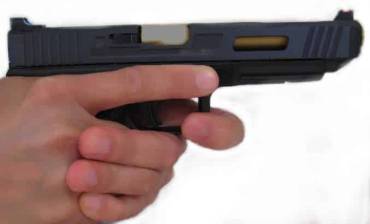This is an old revision of the document!
Pistol Grip
Rather than discuss a revolver, I'll describe this concept of “grip” as it relates to three of the most popular semiautomatic pistols in the world; which are the Smith & Wesson M&P® Shield™, the Glock, and the model 1911.
Thumbs Forward
The “thumbs forward” grip (shown below) is the most popular pistol grip today.
https://www.youtube.com/watch?v=AD_XjZSUdmg
The 1911 Grip
The grip for a model 1911 is very similar to the “thumbs forward” grip… with only one MAJOR difference. The proper grip for a 1911 pistol is to place the thumb of the dominant hand over the "thumb safety" (to ensure that the “safety” is OFF). Many Instructors fail to recognize “why” the “safety” is located where it is on the model 1911 pistol. Teaching students to use the “thumbs forward” grip with the thumb below the “thumb safety”… where it could be accidentally engaged during shooting, would REALLY be bad if the pistol were being used in a defensive situation. Also, learning to always press the “safety” OFF when getting into a shooting stance reduces the potential for accidentally leaving the safety ON in a stressful situation where the pistol is needed. Another benefit of placing the thumb over the “safety” is that the higher grip provides greater stability.
Finger Forward
Unfortunately, many Instructors discourage using the “Finger Forward” or “Finger over trigger guard” grip - mistakenly believing it to be obsolete and inferior to their more familiar “thumbs forward” grip (shown below) - which actually provides LESS contact with a Glock (which is bad)! However, the “thumbs forward” grip is the proper grip for almost every other semiautomatic pistol (e.g., the Smith & Wesson M&P® Shield) EXCEPT the model 1911.
The grip for a model 1911 is very similar to the “thumbs forward” grip… with only one MAJOR difference. The proper grip for a 1911 pistol is to place the thumb of the dominant hand over the "thumb safety" (to ensure that the “safety” is OFF). Many Instructors fail to recognize “why” the “safety” is located where it is on the model 1911 pistol. Teaching students to use the “thumbs forward” grip with the thumb below the “thumb safety”… where it could be accidentally engaged during shooting, would REALLY be bad if the pistol were being used in a defensive situation. Also, learning to always press the “safety” OFF when getting into a shooting stance reduces the potential for accidentally leaving the safety ON in a stressful situation where the pistol is needed. Another benefit of placing the thumb over the “safety” is that the higher grip provides greater stability.
Another difference regarding the grip is the design of the pistol. Notice that the front of the trigger guard on a Glock curves slightly inward with small (serrated) ridges in front of it, while the trigger guard on both the Smith & Wesson M&P® Shield and 1911 curves outward and is smooth. This is because Glocks were “designed” to be held using the “Finger Forward” or “Finger over trigger guard” grip (shown below).
Unfortunately, many Instructors discourage using the “Finger Forward” or “Finger over trigger guard” grip - mistakenly believing it to be obsolete and inferior to their more familiar “thumbs forward” grip (shown below) - which actually provides LESS contact with a Glock (which is bad)! However, the “thumbs forward” grip is the proper grip for almost every other semiautomatic pistol (e.g., the Smith & Wesson M&P® Shield) EXCEPT the model 1911.
The grip for a model 1911 is very similar to the “thumbs forward” grip… with only one MAJOR difference. The proper grip for a 1911 pistol is to place the thumb of the dominant hand over the "thumb safety" (to ensure that the “safety” is OFF). Many Instructors fail to recognize “why” the “safety” is located where it is on the model 1911 pistol. Teaching students to use the “thumbs forward” grip with the thumb below the “thumb safety”… where it could be accidentally engaged during shooting, would REALLY be bad if the pistol were being used in a defensive situation. Also, learning to always press the “safety” OFF when getting into a shooting stance reduces the potential for accidentally leaving the safety ON in a stressful situation where the pistol is needed. Another benefit of placing the thumb over the “safety” is that the higher grip provides greater stability.
<note>The reason that there is so much debate over the “proper” or “correct” way to grip a handgun relates directly to people watching how successful competitive shooters grip their handguns. It's all “monkey-see, monkey-do”. For example, the “Finger Forward” or “Finger over trigger guard” grip popularity originated from the competitions that Lt. Col. Jeff Cooper (founder of "Gunsite Academy") had organized in Big Bear, California. These same competitions were the preface to what is now the IPSC (International Practical Shooting Confederation). Many very good competitive handgun shooters were observed placing their index finger of the support hand on the trigger guard for stability. Consequently, the squared trigger guard was very in vogue during the ’60s, ’70s, and most of the ’80s. In firearm magazine articles from the 1980s, most if not all of the writers were placing their index finger on the front of the trigger guard. Some writers would bemoan the lack of a trigger guard finger rest if a particular handgun lacked that feature!
The bottom line is that IF a handgun has a “finger rest” trigger guard, then it is “intended” to be used as such. And, unfortunately for people with small hands, the vast majority of handguns designed with a “finger rest” trigger guard also require a double-stack magazine. These include, but are not limited to:
IF a pistol doesn't have a “finger rest” trigger guard and is NOT a model 1911, then it was probably designed to be held using the popular “thumbs forward” grip. And while MANY Instructors today INCORRECTLY teach the “thumbs forward” grip as the only proper way to grip a handgun - none of them are going to tell Angus Hobdell (US Multi Grand Master, 5 Times STI / American Handgunner Shoot-Off winner, Multi British & European Champion), that he's holding his pistol wrong (as he uses the “Finger over trigger guard” grip)!
In reality, there is no one perfect grip for everyone. The “best” grip is the one that allows YOU to best hit targets with accuracy and precision.
</note>
Made for concealment, the Smith & Wesson M&P® Shield™ has a single-stack magazine. So it's much easier for people with small hands to grip. However, it is a very small, lightweight handgun (which means greater recoil than a heavier handgun) with a very short distance between its sights (which translates into less accuracy). All of this can be problematic for people who are smaller than average and rarely practice. The handle on the Smith & Wesson M&P® Shield (and many other compact pistols) is shorter than a full-sized pistol. So many people use an extended magazine to allow for a “full” grip… as well as provide more rounds.





